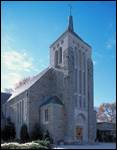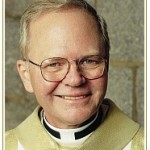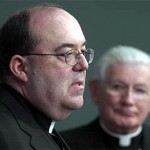Fr. Ron Pytel’s homosexual lifestyle, sexual misconduct, excessive alcohol and other drug use were contrary to his vows and to the very public image he and the Baltimore Archdiocese profited from. There is no question that Fr. Ron Pytel abused his position and his power. In addition to sexual misconduct, Fr. Pytel’s lifestyle and lack of discipline caused financial and other issues at Holy Rosary Church.
Letter to Archdiocese of Baltimore
Abuse Occurred at St. Rita Church in Dundalk
 According to a 1995 document regarding allegations of misconduct against Fr. Ron Pytel, the 1975 incidents of misconduct took place in the rectory at St. Rita Church in Dundalk, Maryland
According to a 1995 document regarding allegations of misconduct against Fr. Ron Pytel, the 1975 incidents of misconduct took place in the rectory at St. Rita Church in Dundalk, Maryland
According to Fr. Pytel’s obituary [ View ] , he earned a theological degree from St. Mary’s Seminary and studied at the North American College in Rome before his ordination as a priest in 1973.
Fr. Ron Pytel Admitted to Molesting Teenager
 The recollection described below was first discussed with an acquaintance of Fr. Ron Pytel at a breakfast meeting in the Baltimore area on April 11, 2011. According to the source, Fr. Pytel bragged about his sexual misconduct with a teenager at a gathering of friends a few years after the misconduct took place. This evening, we received the following statement (via email) from that source:
The recollection described below was first discussed with an acquaintance of Fr. Ron Pytel at a breakfast meeting in the Baltimore area on April 11, 2011. According to the source, Fr. Pytel bragged about his sexual misconduct with a teenager at a gathering of friends a few years after the misconduct took place. This evening, we received the following statement (via email) from that source:
Msgr Richard Woy Knew of Pytel’s Abuse
 For over 15 years, Monsignor Richard Woy, chancellor and director of the Office of Child and Youth Protection of the Baltimore Archdiocese, has been aware of credible allegations of sexual misconduct involving Fr. Ron Pytel. The sexual misconduct with a teenage boy allegedly took place in 1975.
For over 15 years, Monsignor Richard Woy, chancellor and director of the Office of Child and Youth Protection of the Baltimore Archdiocese, has been aware of credible allegations of sexual misconduct involving Fr. Ron Pytel. The sexual misconduct with a teenage boy allegedly took place in 1975.
The Leading Cause of Death
“What’s the leading cause of death?” someone was asked. The answer given was: “Birth!” We are born, knowing that we will die. The baby, who’s birth in Bethlehem we prepare to celebrate, would die a few short years later in Jerusalem. Father Ron Pytel, who received a miracle sparing his life of one disease, would die a few years later of another disease. Does the life and death of this Jesus help us to understand our own lives and deaths? I think it does.
Mary Faustina Kowalska
Sister Mary Faustina, an apostle of the Divine Mercy, belongs today to the group of the most popular and well-known saints of the Church. Through her the Lord Jesus communicates to the world the great message of God’s mercy and reveals the pattern of Christian perfection based on trust in God and on the attitude of mercy toward one’s neighbors.
Would I Live Differently…
There is little doubt that the Risen Christ chose St. Faustina to be His messenger of mercy. When I read her Notebooks, now published as the Diary of St. Faustina, I was awed by the theological and philosophical truths of the Faith, that are found in her writing. Most of what I know about God, and the things of God, come from years of formal study at several universities. I learned from Franciscan, Jesuit, Dominican, and the Spiritan Holy Ghost Fathers, professors, excellent teachers all, and I also learned from the self-study of the writings of the Theologians and Sainted Doctors of the Church. So to learn yet more, from this third grade educated farmer’s daughter, my cousin, comes as a bit of a surprise. Yet, admittedly, it is so.
Cardiologist Moved by St. Faustina
If there was ever any doubt in Dr. Valentin Fuster’s mind about the fairness and accuracy of the Vatican’s process for evaluating miracles, those doubts are gone.
Faustina’s Canonization
A festive St. Peter’s Square was bedecked with spring flowers and budding saplings as the Church celebrated the first canonization of the Jubilee year and Pope John Paul II’s formal announcement that the Sunday after Easter would henceforth be known as “Divine Mercy Sunday.”
Faustina’s Miracles
St. Faustina (1905-1938) was a member of the Congregation of Sisters of Our Lady of Mercy in Poland. Saint Faustina’s mission to mankind began when she had a vision of Jesus Christ on Feb. 22, 1931. He came with a message of trust in God’s mercy that she was told to spread throughout the world.
Living Proof
Father Ron Pytel has had some big days, but few were as important as Mercy Sunday 2000. “After my ordination, it was the most emotional day of my life,” Fr. Ron says of standing alongside the Holy Father on April 30 and hearing him declare Sr. Maria Faustina the first saint of the Great Jubilee.
Audio – Ron Pytel
Fr. Ron Pytel tells the story of his miraculous healing through the intercession of Saint Faustina.
Personal Testimony of Father Ronald P. Pytel
My name is Father Ronald Pytel, and I am the pastor of Holy Rosary Church in Baltimore, Maryland. Our parish church is the Archdiocesan Shrine for Divine Mercy. It is also noteworthy to mention that Pope John Paul II visited and prayed in Holy Rosary Church in 1976 when he was Karol Cardinal Wojtyla. The Divine Mercy Shrine at Holy Rosary was dedicated on the first feastday of Blessed Faustina.
Skeptic #1
The teachings attributed to Sr. Faustina are demonic, not in agreement with the Word of God. Carefully notice the above Satanic teaching … “Entreating God’s mercy for the whole world and particularly for sinners, among others through the practice of new forms of devotion to the Divine Mercy presented by the Lord Jesus, such as: the veneration of the image of the Divine Mercy…”
Why is Divine Mercy So Important?
On Friday, April 30, 2010, we marked the tenth anniversary of the canonization of St. Maria Faustina, the “Apostle of Divine Mercy.” What’s the big deal about St. Faustina and her revelations? A lot! Let’s take a look.
Faustina Facts
Saint Faustina Kowalska (1905-1938)
Born: Aug. 25, 1905, Glogowiec, Poland
Birth Name: Helena Kowalska
Religious Name: Saint Maria Faustina Kowalska of the Most Blessed Sacrament
Entered Religious Life: Aug. 1, 1925, Congregation of Sisters of Our Lady of Mercy, Krakow, Poland
First Vision of Christ: Feb. 22, 1931
Died: Oct. 5, 1938, Krakow, Poland
History of Holy Rosary Parish
The history of Holy Rosary Parish in Baltimore mirrors the early history of the Poles who left their native land to settle here in search of a better life with personal, political and religious freedom. The beginning of this ethnic parish reaches back to the end of the 19th century, to a time when a rapidly growing Polish immigrant community availed itself of the former Protestant church on Eastern Avenue and finally, in 1927, built the present magnificent church on Chester Street. The present church is considered to be one of the largest and finest examples of church architecture found in the Archdiocese of Baltimore.
Skeptic #2
The Catholic Church declared Sr Faustina Kowalska (1905-1938) to be a saint. She bears the distinction of being the first saint canonised in the new millenium. She died in Cracow. It was through her that Jesus supposedly established the Devotion to Divine Mercy in a series of visions and revelations. These visions were delusions and there is an abundance of evidence that this was so in her diary, Divine Mercy in My Soul. She did not bother correcting and rereading her revelations not caring if she accidentally taught heresy or got the devotion discredited (xix, xx). Her book, which she intended for the world to see after she was dead, contains immodest boasts like that she would die a thousand deaths to avoid committing the slightest sin (page 152). To choose that is as bad as choosing a thousand suicides.
Continue reading
What is Devine Mercy?
Miracles attributed to the intercession of Sr. Maria Faustina lead to her canonization on April 30, 2000. Today, people from around the world rely on St. Faustina to interceed on their behalf to Our Lord.
